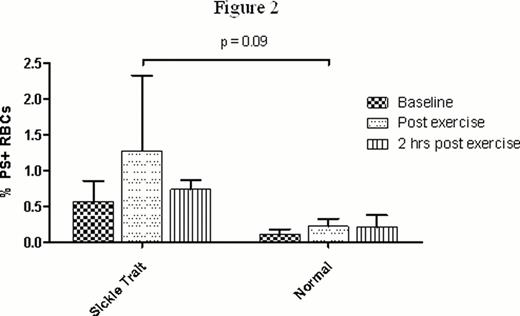Abstract
Abstract 3224
The acute physiological response to strenuous exercise is characterized by a transient hypercoagulable state as well as an acute inflammatory response. Despite these well-recognized findings, the mechanisms involved in these exercise-induced effects are not well understood. To further evaluate the effect of exercise on multiple hematologic parameters, subjects underwent an exercise protocol with blood samples obtained at several time points.
Fifteen healthy male African-American subjects [10 normal hemoglobin (HbAA), 5 sickle cell trait (HbAS)], ages 18–35, exercised at 65% of VO2max × 30 min followed by an increase in treadmill grade of 2.5% every 3 min until volitional exhaustion. Blood was collected at baseline, immediately post-exercise, and at 1 and 2 hours post-exercise. Analyses included CBC, D-dimer, sVCAM, LDH, haptoglobin, plasma free hemoglobin (PF Hb), RBC phosphatidylserine (PS) exposure (by flow cytometry), microparticle (MP) procoagulant activity (Zymuphen MP-activity assay measuring ‘PS equivalents’), and MP-tissue factor (MP-TF) activity (in-house chromogenic assay). Flow cytometric enumeration of MPs in platelet poor plasma was performed using a standardized ISTH protocol, and included platelet MP (PMP: AnnV+/CD41+), endothelial MP (EMP: CD31+/CD41−), red cell MP (RBC MP: AnnV+/CD235a+), leukocyte MP (LMP: AnnV+/CD45+), and monocyte MP (MMP: AnnV+/CD14+) analyses.
As previously reported, increases in total WBC count, monocyte count, and sVCAM occurred immediately after exercise, with return towards baseline thereafter. A similar transient increase was seen with both MP procoagulant activity and MP-TF activity (Fig. 1), with a 2.5- (p<0.01) and 3-fold (p<0.01) increase, respectively. Acute increases were also observed for PMPs, EMPs, LMPs and MMPs, which peaked immediately post-exercise. No significant changes were noted for D-dimer, Hb, LDH, or haptoglobin; however, a modest increase in PF Hb was noted following exercise. Interestingly, some unique differences were seen in HbAS compared to HbAA subjects; specifically, EMPs peaked later (at 2 hrs) and were more elevated in HbAS subjects, although the difference was not statistically significant (HbAS 138.2 +/−162.3 EMPs/uL vs. HbAA 65.4 +/− 29.3 EMPs/uL; p=0.26). Additionally, there was a trend towards increased RBC MPs in HbAS subjects (HbAS: 291 +/− 284 RBC MPs/uL at baseline vs. 975 +/− 1033 RBC MPs/uL at 2 hrs; p=0.13). A trend towards increased RBC PS exposure immediately post-exercise in HbAS subjects compared to HbAA was also apparent (Fig. 2), with almost 3× more RBC PS exposure in the HbAS group (post exercise % PS+ RBCs: HbAS 1.28 +/− 1.05% vs. HbAA 0.22 +/− 0.10%; p=0.09, n=4). We also observed a trend towards lower haptoglobin and increased D-dimer in HbAS subjects compared to HbAA subjects at all time points.
These data confirm previous observations reporting systemic activation of coagulation occurring after strenuous exercise, and demonstrate a transient increase in MP-TF activity. Interestingly, the time course and magnitude of this activity differs from that seen in the human endotoxemia model (data not shown), in which there is a 5–7 fold increase in MP-TF activity that peaks much later (4 hours) post LPS exposure. The much earlier peak and lower magnitude (∼ 3-fold increase) with exercise suggest a mechanism that does not involve cellular synthesis of TF but is instead likely due to a release of pre-formed TF stores. Other findings in this study may also be relevant to the pathophysiology of the well-documented risk of exertional sudden death with sickle cell trait. In particular, we speculate that the increased RBC PS exposure, elevated RBC MPs and a relative increase in EMPs may contribute to increased activation of coagulation and occlusion of the microvasculature during exercise that may result in DIC, rhabdomyolysis and sudden death.
No relevant conflicts of interest to declare.
Author notes
Asterisk with author names denotes non-ASH members.



This feature is available to Subscribers Only
Sign In or Create an Account Close Modal